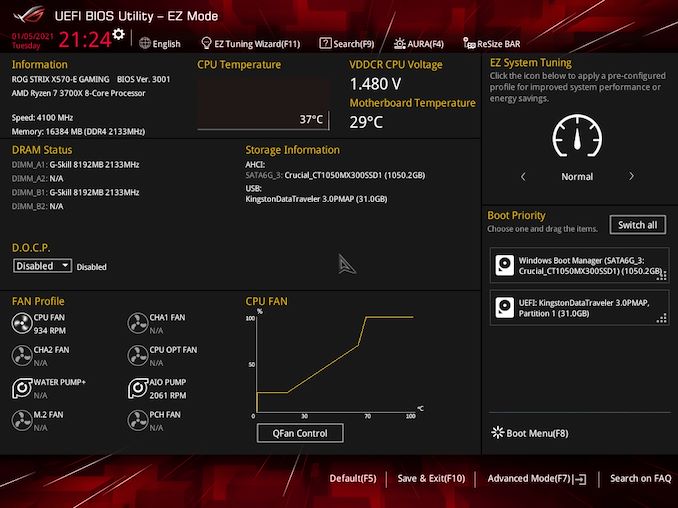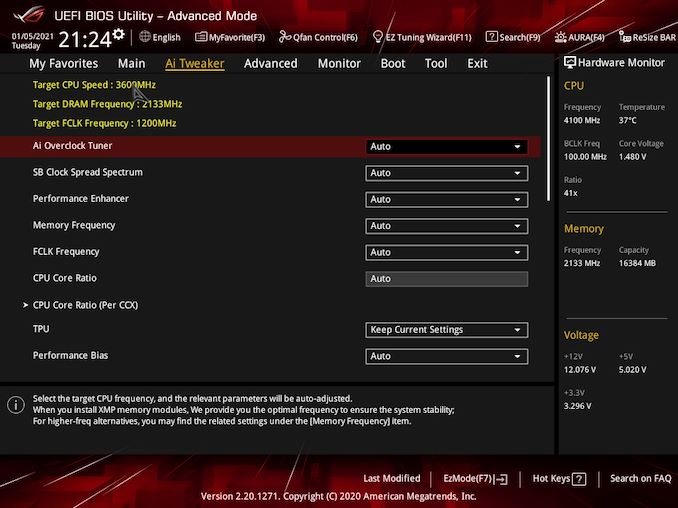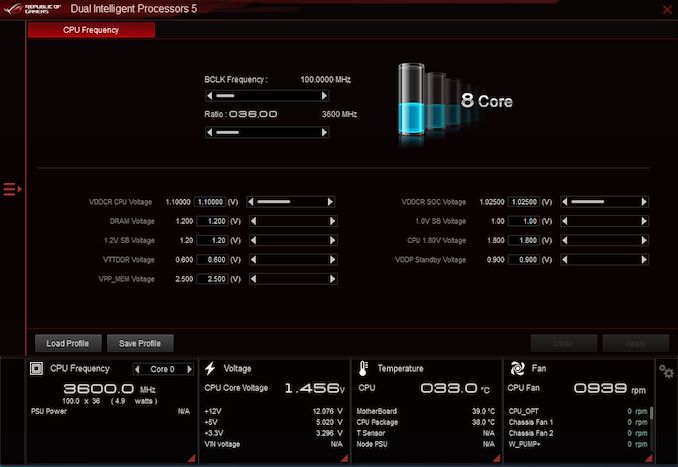The ASUS ROG Strix X570-E Gaming Motherboard Review
by Gavin Bonshor on January 25, 2021 11:00 AM EST- Posted in
- Motherboards
- AMD
- Asus
- ROG
- AM4
- Ryzen 3000
- X570
- Strix X570-E
- Ryzen 5000
- X570-E Gaming
BIOS
ASUS is using its Republic of Gamers firmware which has two primary modes with different levels of complexity: EZ and Advanced. The design of the BIOS is consistent throughout, with a ROG themed red, black and dark background, with contrasting grey and white text. This design used in both the EZ and Advanced modes which users can access by pressing the F7 key.
The basic 'EZ' mode is for novice users looking to make basic alterations. This includes basic XMP support (which ASUS calls DOCP on its AMD based models). On the basic screen is a list of core information including fan profile speeds, DRAM status, model and firmware version, current CPU Core voltage, and motherboard temperature. Users can use hotkeys to navigate between different sections of the firmware, as well as select the systems boot priority and access the QFan Control function integrated into the firmware.
Accessing the more intricate parts of the firmware, users will need to press F7 to switch to the Advanced mode. This area is where all of the board's primary settings are located and are divided into menus and submenus. The Ai Tweaker is where all of the overclocking settings are located and users can overclock the CPU, memory, and integrated graphics when used with a compatible Ryzen based APU.
It offers control for CPU frequency, Fabric Clock frequency (FLCK), which users can adjust to allow AMD's Infinity Fabric to operate in tandem with memory frequency. AMD recommends an FCLK of 1800 MHz when using DDR4-3600 memory which it says is the sweet spot for performance on the Ryzen platform. For quick and easy memory overclocking, users can enable D.O.C.P,.
Other notable elements of the firmware include its AURA section which allows users to customize the board's integrated RGB LEDs. The software offers much more in-depth control of this, but it's nice to see that AURA and the QFan utility make it into the firmware. As we've seen with previous ASUS ROG models over the last couple of years, its firmware is consistent, intuitive, and laid out very neatly.
Software
Some of the following analysis comes from our ASUS ROG Strix B550-F Gaming review as it shares the same software bundle as the ROG Strix X570-E Gaming.
One of the unique ASUS implementations to its Republic of Gamers branded motherboards is the Armory Crate, which is pooled into memory on the motherboard and contains basic networking drivers and all the software and utilities. Armory Crate pops up when Windows is first installed onto a system, so it looks like somehow ASUS has got into your install image. Not a fun thing if you don't know about it in advance.
Thankfully this is just some extra software that helps most users get hold of chipset and controller drivers as needed. It can be disabled in the BIOS if needed. Note this means that the Driver CD traditionally bundled with a motherboard isn't really needed, as long as you have an internet connection.
The ASUS AI Suite 3 utility is a combination of various software utilities that allow customization of power profiles, VRM power profiles, and load-line calibration settings. This also stretches to overclocking for the CPU, with options to adjust both CPU and BCLK frequency. Users can also make on the fly adjustments to voltages such as CPU VCore, memory voltage, and SoC voltages, although the firmware still offers the most for overclockers and enthusiasts. The AI Suite 3 software also allows access to its QFan tuning utility where users can customize fan profiles.
Other utilities in the ASUS package include the ROG Gamefirst VI network traffic shaping software, a custom skinned version of the CPU-Z monitoring utility, and its RAMCache III software. The ASUS Sonic Studio application also allows users to customize its auditory experience with effects and different sound profiles for things such as movies, music, and gaming. This includes frequency EQ customization too. As usual, the ASUS software package includes plenty of software to enhance user experience.


























46 Comments
View All Comments
pradeepsekar - Tuesday, January 26, 2021 - link
Correct.Just sharing my experience -
I got a 5950X and Corsair 3600 C18 RAM from the QVL. Loaded up the latest BIOS 2802 and them boom - error and the board would not boot. Had to take it to the ASUS service center, and wait for over an hour. The engineer assigned was super helpful though. He had me wait for some time, and tested the board with a lower processor. He downgraded the BIOS to the next lower stable version, and it worked well when I got it home. Now I am on 3001 and everything continues to work fine. It occasionally greets me with multiple beeps, but ends up booting into Windows anyways... Need to investigate that more but it is not replicable... Anyways, I will stay away from the beta BIOS versions :-)
I agree about the placement of the chipset and the graphics card - they are right next to each other. I am on a NVIDIA Founders edition card. It blows all the warm air out of the chassis and not into it. So for the moment I have not seen high temperatures (yet). The chipset fan looks like a tiny fragile thing one would see on a laptop - with a lot of potential to make a noise when it gets running at a high speed...
Coming from a much older version the menus took some getting used to. All options are present and laid out neatly, as I realized later - with several options that I do not understand fully, and hence do not intend touching till I know better! Just got the RAM running with the XMP (DOCP) profile. I do not intend to overclock the processor - a crazy thought perhaps, but my rig is already screaming fast at everything I throw at it...
Spunjji - Tuesday, January 26, 2021 - link
Beaver M. could learn a lot about what a persuasive, measured post looks like from this one. Cheers for sharing your experience.Knightworld - Wednesday, January 27, 2021 - link
Try running 3200 MHz for the RAM XMP profile. That's what the highest the CPU can handle while being stable without OC. That's the recommended by AMDKnightworld - Wednesday, January 27, 2021 - link
Well of coarse there will be BIOS updates. This is quite an old board in terms of computer standards. Lots of chipset optimisations to accommodate Zen 3 ryzen.Knightworld - Wednesday, January 27, 2021 - link
Also the chipset placement is pretty standard in all boards. Be it ASUS and MSI or Gigabyte or any other MoBo manufacturer. The chipset doesn't ramp up in boost or anything so it usually remains at a constant temp. And using the second slot for main GPU cause more strain on the chipset, since the second slot connects to the chipset and not the CPU. Also with the new GPU from Nvidia, the 3000 series your chipset shouldn't have any issues with the cooling since the special GPU coolers help with that. Tho that is only if you upgrade the GPU.Oxford Guy - Monday, January 25, 2021 - link
'Both the CPU and SoC are Teamed together, which allows the power delivery to run cooler and it improves transient response with quicker bursts of power without the drawbacks of phase doublers.'What drawbacks?
Oxford Guy - Monday, January 25, 2021 - link
'This is also typically run at JEDEC subtimings where possible. It is noted that some users are not keen on this policy, stating that sometimes the maximum supported frequency is quite low, or faster memory is available at a similar price, or that the JEDEC speeds can be prohibitive for performance. While these comments make sense, ultimately very few users apply memory profiles (either XMP or other) as they require interaction with the BIOS. Most users will fall back on JEDEC supported speeds'1. Reviews expensive enthusiast board, where we literally are told about what specific VRM components are present.
2. Makes claims above.
3. Facepalm.
nils_ - Monday, January 25, 2021 - link
I saw this in another benchmark article as well. Know your audience Anandtech, of course we care about this. Most people don't build their own computers, so why even benchmark individual components?Spunjji - Tuesday, January 26, 2021 - link
I'd go as far as to say this is the first instance where I've seen this particular criticism being levelled and haven't been inclined to immediately dismiss it. That text doesn't really belong in this article.Oxford Guy - Monday, January 25, 2021 - link
1. Most users aren't going to use POV-Ray so don't include it in the article.2. Most users aren't going to worry about what VRM components are on the board so don't include it in the article.
3. Most users aren't going to use a RAID array so don't include information about RAID in the article.
4. Most users aren't going to use ethernet that's any faster than gigabit so don't including info about that in the article.
How long should this post be? It's the exact non-credible argument used to test at JEDEC. Now that AMD is rating, officially, for 3200 (which means even the lowest-quality AM4 board will support it), the problem isn't as severe as it was but it's still stupid since everyone has known that 3600 was the sweet spot for the previous round of Zen, not 3200.